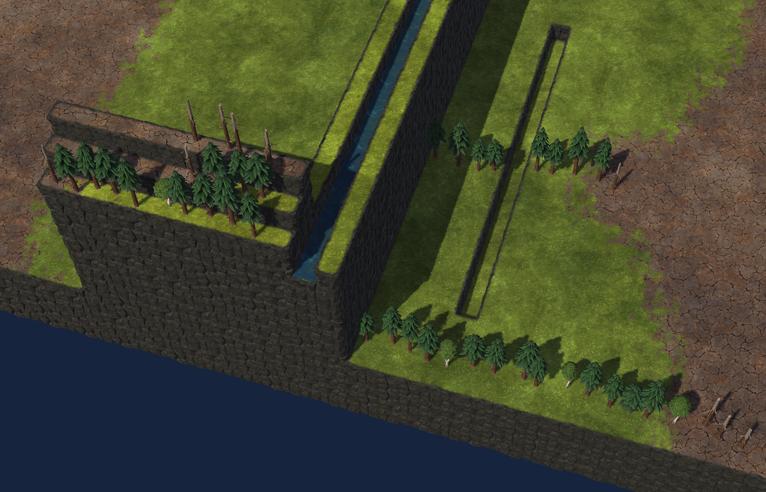Fluids
Water
A flowing water is a physical water body that is present on the map and is produced by a ![]() Water Source.
Water Source.
Flowing waters' strength is measured in cms (cubic meters per second). It takes 2 seconds for a current of 1 cms to fill up a single block with water, because water simulation runs at 0.5x speed. This means it takes 2 seconds for 1 "water second" to pass.
Water can freely flow between tiles where there's a difference in the height of the water. When water passes a waterfall (a difference of +0.5 height) the water flows' strength is limited to 2.2 cms. Water flow calculations are applied only on the top level of the water.
Water current and strength is essential for creating power with water wheels. The current's strength can usually be strengthened by narrowing the water's path with dams and/or other structures that block water. A ![]() Stream Gauge can be placed in the water to measure the current depth, maximum depth, and flow rate.
Stream Gauge can be placed in the water to measure the current depth, maximum depth, and flow rate.
Water Pumps can be used to extract and purify ![]() water resource from flowing water.
water resource from flowing water.
Evaporation (outdated)
Water has a constant evaporation rate of 0.045 meters per day regardless of the ![]() weather. A full, non-flowing block of water will take just over 22 days to completely evaporate, if there are no water pumps. The evaporation is calculated only on the top level of a tile. This means that when storing water on reservoirs it might be a good idea to go for depth rather than more area so the water loss due to evaporation is not as severe.
weather. A full, non-flowing block of water will take just over 22 days to completely evaporate, if there are no water pumps. The evaporation is calculated only on the top level of a tile. This means that when storing water on reservoirs it might be a good idea to go for depth rather than more area so the water loss due to evaporation is not as severe.
Smaller water bodies will now disappear faster in Update 5. The evaporation rate depends on the width and area of the water body, and the decisive factor is the width of the river channel rather than the total area. The following lists the evaporation rates under different area conditions.
1*1 grid water: 0.297 meters per day
1*10 grid water: 0.210 meters per day
2*5 grid water: 0.107 meters per day
2*10 grid water: 0.103 meters per day
3*10 grid water: 0.060 meters per day
5*10 grid water: 0.053 meters per day
The use of canals to irrigate farmland has become a thing of the past in Update 5.
Storage
Water can be stored inside tanks or as is on the map by using dams, levees and other landscaping tools. Advantage of the tanks is that it stores straight drinkable water and can be close inside your district. Natural reservoirs on the other hand can store much larger quantities and can be built away from the districts.
1 full block of water will provide 5 units of drinkable water, and each beaver will need 2-3 units per day. This means that a small tank with a capacity of 30 can store water equal to 6 full blocks of water. Similarly a medium tank with a capacity of 300 can hold up to 60 full blocks of water. Added benefit of the water tanks is that they do not suffer from evaporation.
Irrigation (outdated)
Water irrigates soil, allowing Crops and Trees to grow, and ![]() Ruins to have vines grown on it.
Ruins to have vines grown on it.
Water creates irrigated soil nearby. The distance of irrigated soil from the water depends on the relative height of the land next to it.
A watered block is a block that is in direct contact with water, either below it or directly touching it on the side. From that watered block, soil at the same height will be irrigated up to 15 blocks away in any direction.
Each difference in height from the watered block subtracts from the distance of 15. If on top of the watered block, the irrigated distance is reduced by 6. If separate, the distance is reduced by 7.
The first block after the watered block can be at any height below its height without affecting the irrigation distance.
Update 5 changed the irrigation rules. See here for a small test of irrigation ranges. The irrigation range now also depends on the width of the channel/pod (width 1: 6 blocks, width 2: 12 blocks, width 3: 16 blocks).
Badwater



